Innovation at Scale: Georgia Tech Unveils New Roll-to-Roll Manufacturing Pilot Facility
Oct 03, 2024 —

Partners of the facility gathered for an official ribbon cutting ceremony. From left to right: Eric Vogel, Hightower Professor in MSE and executive director for the Institute for Matter and Systems; Devesh Ranjan, Eugene C. Gwaltney, Jr. school chair and professor in the George W. Woodruff School of Mechanical Engineering; Julia Kubanek, vice president of Interdisciplinary Research; Tequila Harris, professor in the Woodruff School and facility leader; Christine Conwell, interim executive director for the Strategic Energy Institute; Tim Liewen, interim executive vice president for Research; Thomas Kurfess, Regent's Professor in the Woodruff School and executive director of the Georgia Tech Manufacturing Institute; J. Carson Meredith, professor and James Preston Harris Faculty Fellow in the School of Chemical and Biomolecular Engineering, executive director of the Renewable Bioproducts Institute. Photo: Christopher McKenney.
Whether it’s developing new products, reducing costs, or increasing accessibility, innovations in manufacturing stand to improve the lives of companies and consumers alike. Georgia Tech recently took another step toward ensuring those innovations make it from lab to market with the launch of a Modular Pilot Scale Roll-to-Roll Manufacturing Facility.
“As researchers develop new materials, one of the key aspects we’re missing is how to make them at scale. This is a major oversight because if we can’t make them at scale, we can’t transition from basic research to commercialization,” said Tequila Harris, a professor in the George W. Woodruff School of Mechanical Engineering. “With this new facility, we can prove our discoveries beyond lab-scale studies — and can go from materials innovation to product development at scale.”
Led by Harris, the new facility is the result of a partnership between the Georgia Tech Manufacturing Institute (GTMI), the Strategic Energy Institute, and the Woodruff School. As a pilot facility, it will serve as a testbed for scaling up manufacturing research open for Georgia Tech researchers as well as academic, government, and industry partners around the world.
“The larger vision I see at Georgia Tech involves innovation in manufacturing for large-scale industries,” said Georgia Tech’s Interim Executive Vice President for Research Tim Lieuwen at the facility’s unveiling event on Sept. 19. “It’s crucial that we’re innovating in basic science and technology, but we also need to be innovating in large-scale manufacturing.”
Roll-to-roll (R2R) manufacturing transforms flexible rolls of substrate materials, such as paper, metal foils, and plastics, into more complex, transportable rolls upon coating the surface with one or more fluids, such as inks, suspensions, and solutions, which are subsequently dried or cured on the base substrate. Its high yield and efficiency make R2R an ideal method for the sustainable, large-scale production of components for solar cells, batteries, flexible electronics, and separations — all industries that have expanded in Georgia in recent years.
“As a state institution, we’re ultimately here to serve our state,” said Lieuwen, who is also Regents’ Professor and David S. Lewis Jr. Chair in the Daniel Guggenheim School of Aerospace Engineering. “We’re seeing Georgia emerge as the national leader in terms of recruiting corporate investments in this space and in industries that will be served by this facility.”
Roll-to-Roll Innovations
The R2R process is similar to the production of newspapers, where a large roll of blank paper goes through a series of rollers printing text and photos. “The roll-to-roll aspect is the process of using a specialized tool to force fluid onto a moving surface,” says Harris. It’s one of the fastest-growing methods for producing thin film materials — photovoltaics used in solar cells, transistors in flexible electronics, and micro-batteries, for example — at a large scale.
Harris’s group works to develop novel manufacturing tools, with a particular focus on understanding and improving the dynamics of thin film manufacturing to increase efficiency and minimize waste. Her group is particularly interested in slot die coating, an R2R technique where a liquid material is precisely deposited onto a substrate through a narrow slot. With the new pilot facility, researchers like Harris will be able to take their work to the next level.
“Slot die coating on a roll-to-roll can handle the broadest viscosity range of most coating methods. Therefore, you can process a lot of different materials very quickly and easily,” says Harris. “It’s one of the fastest-growing technologies in the U.S. — and currently, this is the most advanced modular pilot scale facility at an academic university in the United States.”
“Georgia Tech is way ahead of the curve in terms of our facilities,” says GTMI Executive Director and Regents’ Professor Thomas Kurfess. “This will grow our capability in the battery area, membranes, flexible electronics, and more to allow us to support the development of new technologies.”
“As technologies around cleantech continue to advance at an unprecedented pace, pilot manufacturing facilities provide a critical bridge between innovative benchtop research and commercial-scale production and manufacturing,” says Christine Conwell, interim executive director of the Strategic Energy Institute. “We are excited about the opportunities this R2R facility will provide to the Georgia Tech energy community and our industry partners.”
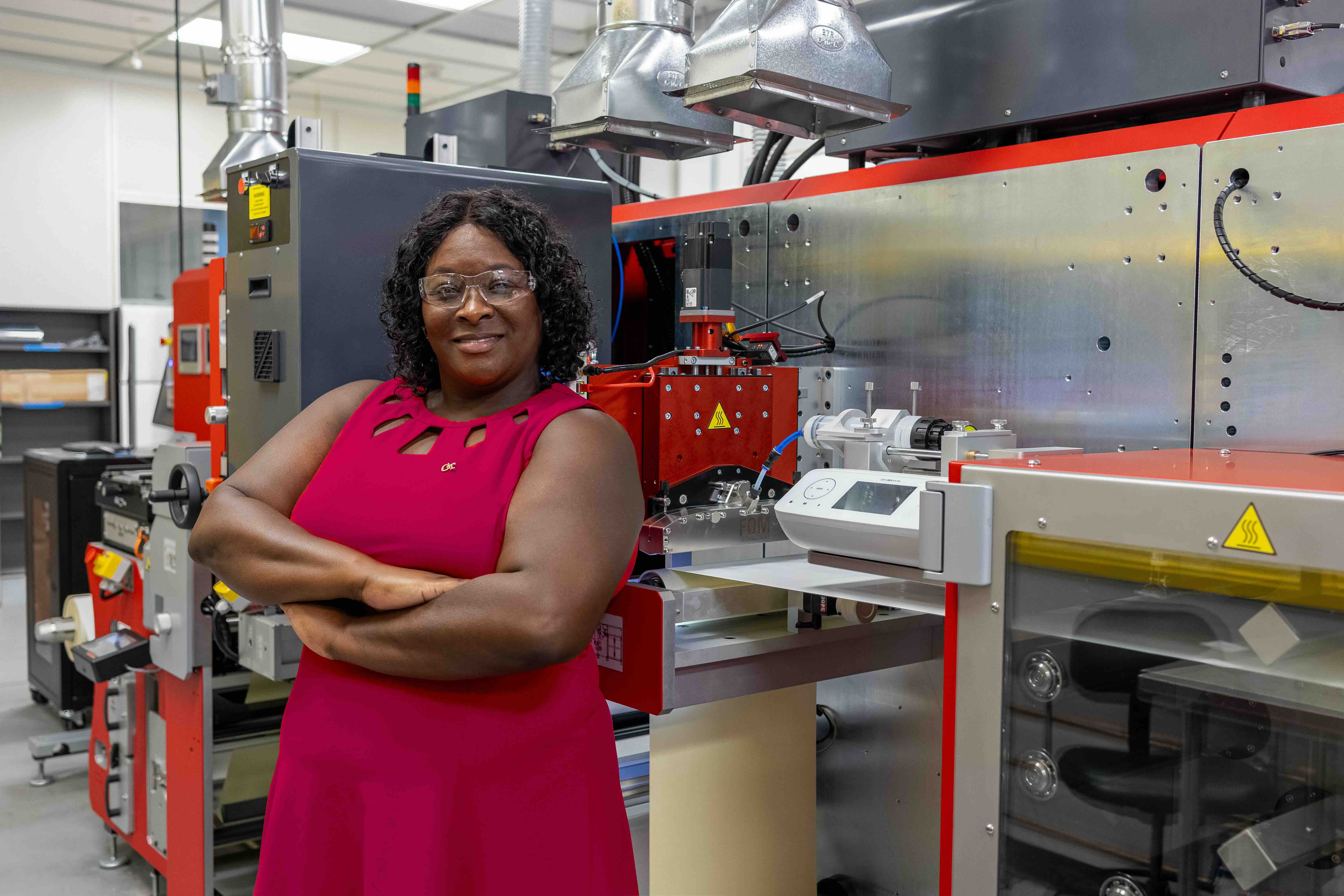
Tequila Harris, professor in the George W. Woodruff School of Mechanical Engineering, next to the modular R2R equipment. Photo: Christopher McKenney.
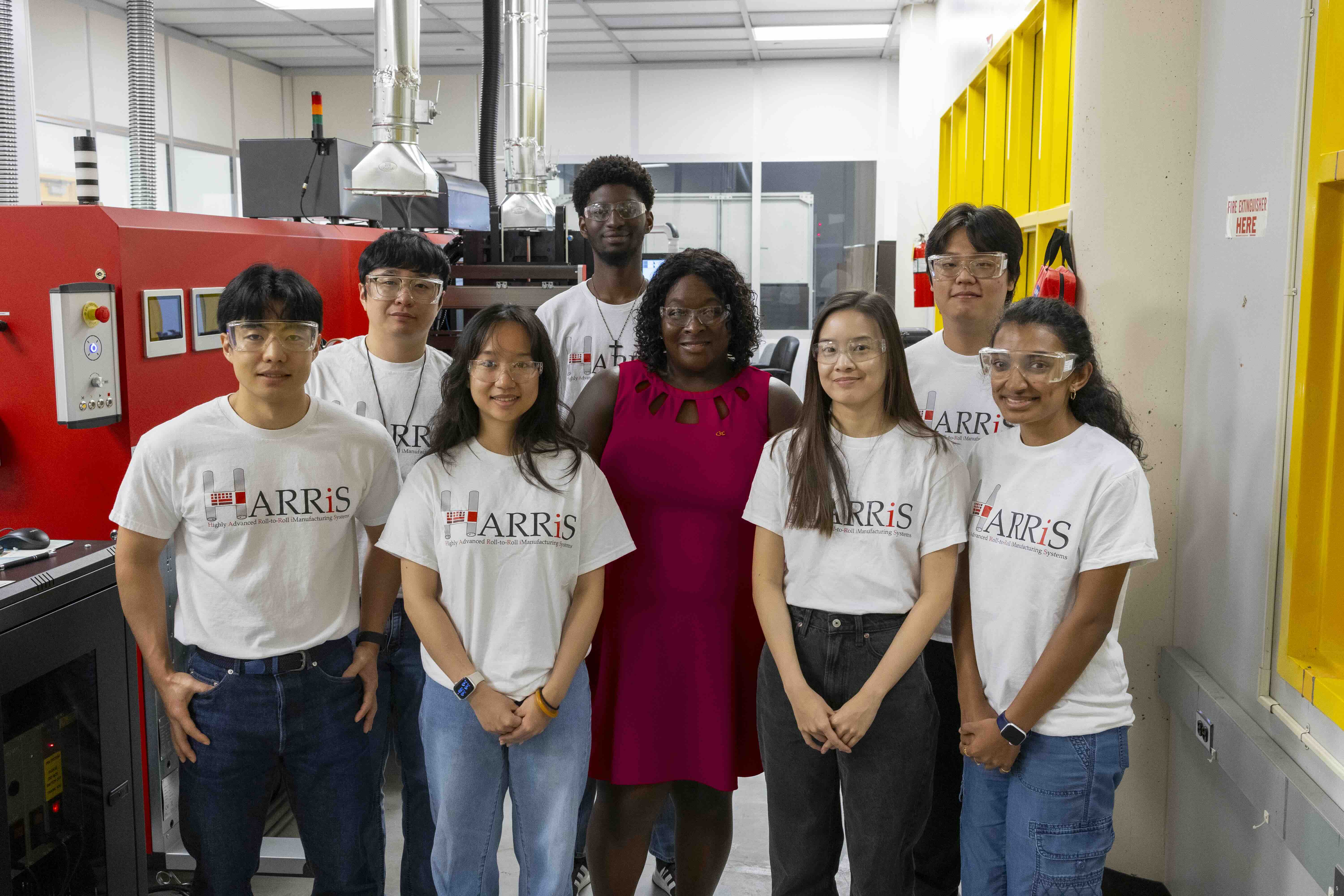
The Highly Advanced Roll-to-Roll iManufacturing Systems (HARRiS) research group in the new R2R facility. Photo: Christopher McKenney.
Audra Davidson
Research Communications Program Manager
Georgia Tech Manufacturing Institute
BBISS Executive Director Search
Oct 01, 2024 —

Please visit this page for up-to-date information about the progress of this search.
The Georgia Institute of Technology (Georgia Tech) invites applications and nominations for the Executive Director (ED) position in the Brook Byers Institute for Sustainable Systems (BBISS). BBISS, one of Georgia Tech’s Interdisciplinary Research Institutes (IRIs), brings together researchers from across Georgia Tech, including academic and research units, to support world-class sustainability-focused research, student engagement, and industry, government, and nonprofit collaboration toward achieving systemic change.
The BBISS ED will be a dynamic, collaborative, and entrepreneurial leader who will unite a broad range of stakeholders around a vision to elevate and grow sustainability at Georgia Tech. As a systems thinker and inclusive relationship builder, the ED will expand and enhance BBISS collaborations and partnerships within and beyond Georgia Tech to broaden its sustainability footprint in local, regional, national, and international arenas.
The ED will catalyze the formation of interdisciplinary teams to support high-impact programming and grants in areas such as climate science, solutions, and policy; ecosystem and environmental health; sustainable cities and infrastructure; sustainable resource and material use; just and equitable sustainable development; and the economics and business of sustainability.
Applications, Inquiries, and Nominations
To apply for the Executive Director position in the Brook Byers Institute for Sustainable Systems, candidates are requested to submit the following:
- A curriculum vitae
- A letter of interest (not to exceed four pages) that summarizes your qualifications and includes a brief statement of your vision for BBISS
- Contact information for five references (to be contacted with candidate’s permission at a later date)
Candidates are requested to send their application materials (in Word or PDF) to the AGB Search Portal at this link by November 19, 2024, for best consideration.
Nominations and expressions of interest for this opportunity are encouraged. Please direct them to BBISSGATech@agbsearch.com or to the AGB search consultants listed below.
Monica Burton, Principal
monica.burton@agbsearch.com
C: 917.825.2961
Nancy Targett, Ph.D., Executive Search Consultant
nancy.targett@agbsearch.com
C: 302.233.5202
Brent Verrill, Research Communications Program Director, BBISS
Scheller Business Insights: Achieving Net Zero Featuring Beril Toktay
Sep 25, 2024 — Atlanta, GA

Scheller Business Insights is a dynamic video series that highlights the innovative thought leadership of the esteemed faculty at the Georgia Tech Scheller College of Business. At Scheller, we are committed to exploring ideas that educate and inform others about the profound impact of business on our lives and the world.
In this episode, Beril Toktay, Regents' Professor and faculty director of the Ray C. Anderson Center for Sustainable Business, defines net zero and discusses some ways to alleviate climate change by reducing carbon emissions to the point of net zero emissions.
Globally, most major polluters, such as China, the U.S., India, and the EU, are among over 140 nations with net-zero goals, which encompasses roughly 88 percent of global emissions. Meeting the Paris Agreement's 1.5°C climate threshold requires 45 percent emissions cut by 2030 and net-zero emissions by 2050 (United Nations Climate Action).
Toktay describes ways this can be accomplished in different business sectors. For example, in the energy sectors, this means moving from fossil fuels to renewable technologies, and in the transportation sector, moving to electrification and innovative battery technologies as well as developing the infrastructure to support these initiatives. These efforts help move businesses towards achieving net zero as well as providing cleaner air and water, and better health outcomes to the global population.
Listen as Toktay discusses what net zero means, the importance of getting to net zero, and how businesses can help reduce carbon emissions.
Lorrie Burroughs
Professor Christopher W. Jones Wins ACS Murphree Award
Sep 13, 2024 —
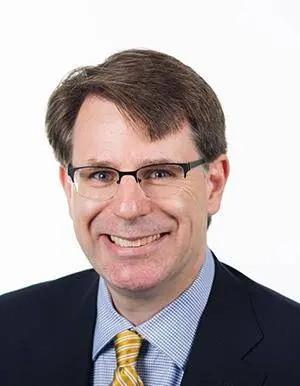
Chris Jones
Professor Christopher W. Jones, the John F. Brock III School Chair of Georgia Tech’s School of Chemical and Biomolecular Engineering (ChBE), is winner of the American Chemical Society’s 2025 E. V. Murphree Award in Industrial and Engineering Chemistry.
Jones will receive the award at the American Chemical Society (ACS) meeting in San Diego, in March 2025. The ACS National Awards encourage the advancement of chemistry in all its branches, support research endeavors, and promote the careers of chemists.
The Murphree Award (including $5,000) won by Jones recognizes fundamental research in industrial and engineering chemistry, the development of chemical engineering principles, and its application to industrial processes.
Associate Professor Matthew McDowell Selected for Emerging Leaders Program
Aug 23, 2024 — Atlanta, GA

Matthew McDowell
Matthew McDowell, Carter N. Paden, Jr. Distinguished Chair and associate professor in the George W. Woodruff School of Mechanical Engineering, has been selected to participate in Georgia Tech’s Emerging Leaders Program. He is among 16 faculty members who will join the program’s ninth cohort.
“On behalf of Institute leadership, we are proud to welcome the next cohort of the Emerging Leaders Program,” said Steven W. McLaughlin, provost and executive vice president for Academic Affairs. “Opening the program to a broader pool of individuals, including our talented research faculty, has been an important programmatic expansion as we seek to foster the leadership aspirations of faculty of all paths. This intensive program is an excellent professional investment, and we applaud the new cohort’s commitment to their careers and to the Institute.”
Starting in Fall 2024 and continuing through Spring 2025, McDowell and other participants will take part in leadership development activities that include a kick-off retreat, regular workshops, small group work, and leadership coaching.
Professor Krista Walton Wins 2024 AIChE Award for Excellence in Industrial Gases Technology
Aug 29, 2024 — Atlanta, GA
Professor Krista Walton was selected as the recipient of the 2024 Institute Award for Excellence in Industrial Gases Technology from the American Institute of Chemical Engineers (AIChE).
Walton, Georgia Tech’s associate vice president for Research Operations and Infrastructure and the Robert "Bud" Moeller Faculty Fellow in Georgia Tech’s School of Chemical and Biomolecular Engineering (ChBE), will receive the award at the AIChE meeting in San Diego, California, this October.
Walton focuses her research on the synthesis, characterization, and scale-up of metal-organic frameworks (MOFs) and other porous materials for adsorption-based gas separations.
Starting more than a decade ago, Walton became one of the few researchers in the world to focus on understanding the chemical stability of MOFs and has gained an international reputation for her work by helping shape the landscape of MOF applications in separations. She has published more than 135 peer-reviewed articles, including a seminal review on the water stability of MOFs in 2014.
Meisha Shofner Selected for ELATES National Leadership Program
Aug 28, 2024 — Atlanta, GA

Meisha Shofner ELATES Fellow 2024-2025
Meisha Shofner, professor in the School of Materials Science and Engineering (MSE), has been selected for the 2024-2025 class of Drexel University’s Executive Leadership in Academic Technology, Engineering and Science (ELATES) program.
The ELATES program is a national leadership development program designed to promote women in academic STEM fields and faculty allies of all genders into institutional leadership roles.
“I am excited to be selected as an ELATES Fellow. I am grateful for the support from Georgia Tech’s College of Engineering that made this opportunity possible and especially support from Dean Raheem Beyah, Associate Dean Kim Kurtis, and MSE School Chair Natalie Stingelin. I am looking forward to learning from this amazing community of women leaders in higher education,” Shofner said.
“I was drawn to the ELATES program because of its focus on developing the skills needed to lead university initiatives with an operational focus, and I will be putting that knowledge into practice as I develop an institutional action project as part of the program.”
2023 RBI Spring Workshop Experience From a Student's Perspective - Part 4
Oct 11, 2023 — Atlanta, GA
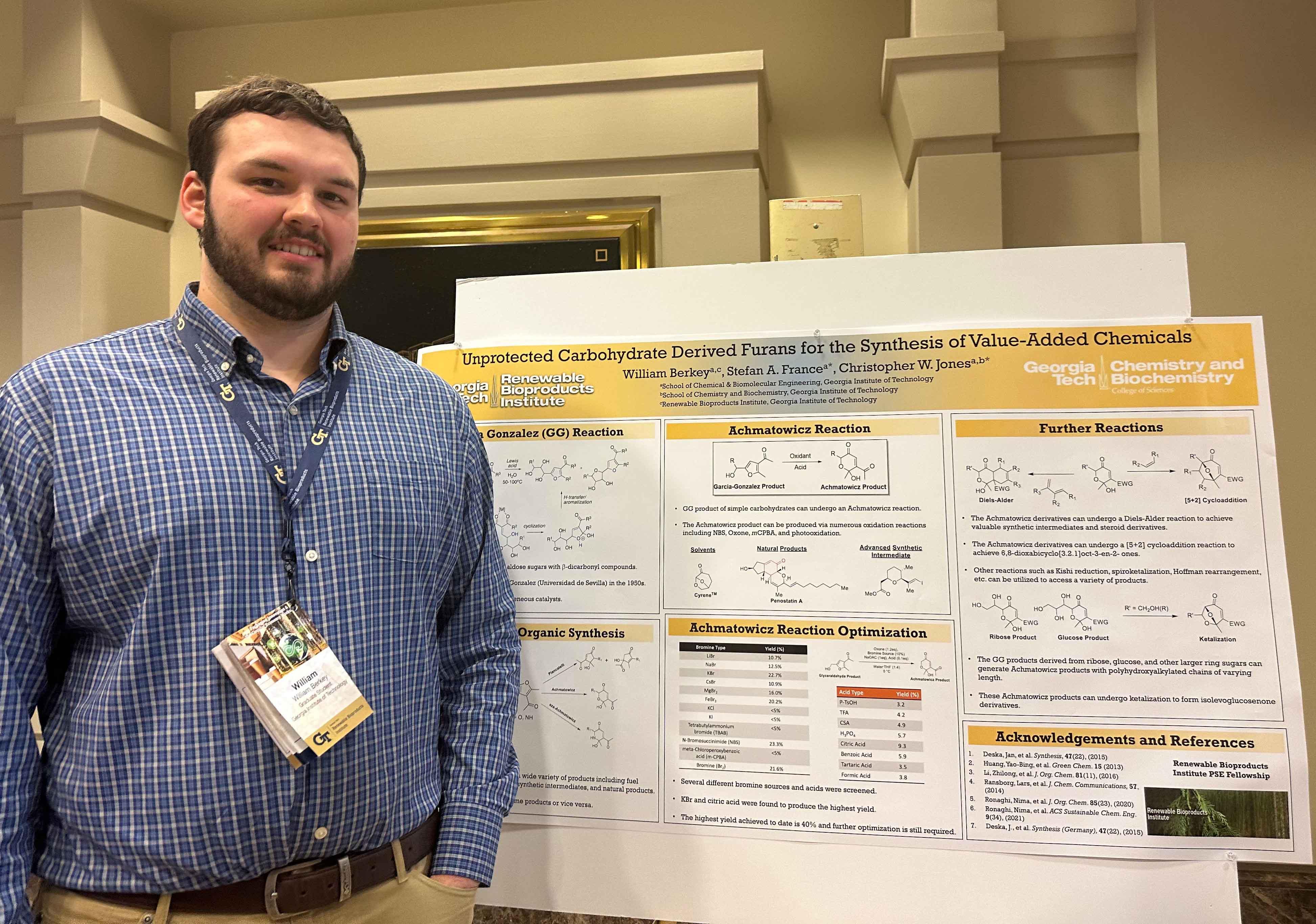
William Berkey at the 2023 RBI Spring Workshop on Innovations in Packaging and the Circular Economy
This is part four of the student experiences series. William Berkey, a Ph.D. candidate in chemistry shares his experience from the 2023 RBI Spring Workshop on "Innovations in Packaging and Circular Economy."
Tell us about yourself.
My name is William Berkey. I got my undergraduate degree in chemistry from Davidson College in North Carolina. I am getting my Ph.D. in chemistry at Georgia Tech. I am co-advised by Stefan France and Christopher Jones. I work on the upcycling of carbohydrates to yield furan-containing building blocks as platforms chemicals and precursors to value-added fuels, materials, and products. Specifically, I work with the Garcia Gonzalez reaction and the Achmatowicz reaction.
The paper I just published as the second author with my mentor Caria Evans (first author) is about converting amino acids — a renewable feedstock — to functionalities pyrroles that can be used for drug molecule development or other bio-active compounds.
How was your experience at the RBI workshop?
I really enjoyed the RBI workshop. It was interesting to see other people’s research and talk with fellow researchers on solving problems and potentially collaborating. The diverse set of talks from industrial, government, and research collaborators shows the wide set of problems still to be solved and different viewpoints on how to solve them. My main takeaway is that through collaboration, solutions to a wide range of problems affecting the industry can be achieved.
What was your main takeaway from the poster session?
What stood out during the poster session was the wide variety of topics that my peers were researching and the interesting findings they discovered. I interacted with several industrial representatives and a fellow Davidson alumnus who works in forest management. I received great advice on how to advance my research as well as how to pursue potential next steps in application.
What more would you like to see in future events at the Renewable Bioproducts Institute?
I would like to see more talks on biorefining. I am interested in interacting with potential collaborators. I would like to see new seminars on research problem-solving or project idea creation.
Priya Devarajan | Research Communications Program Manager, RBI
Valmet Automation Field Trip Showcases Industry 4.0 Technologies
May 05, 2023 — Atlanta, GA

Georgia Tech student trying the virtual reality software systems at the Valmet Lab
Students enrolled in the Spring 2023 course Emerging Technology in Forest Bioproducts (offered by the College of Engineering – ChBE and ME 4730/8803) visited the Valmet Automation Center in Norcross, GA in April. With faculty members Carson Meredith and Chris Luettgen, who teach the course, the visiting group consisted of both undergraduate and graduate students from the School of Chemical and Biomolecular Engineering, George W. Woodruff School of Mechanical Engineering and the School of Material Science and Engineering at Georgia Tech.
The students got an opportunity to see Valmet’s vision for the Factory of the Future through automation and predictive control – Industry 4.0 in some vernacular, and were given an introduction to Valmet as a company and the multitude of career pathways available at the company. Valmet is headquartered in Espoo Finland and develops and supplies process technologies, automation, and services for the pulp, paper, and energy industries. The automation systems and flow control solutions offered by the company serve a wide base of process industries and was the focus area of the field trip.
The Emerging Technologies for Forest Bioproducts course is a required course for RBI Fellowship students and part of the Georgia Tech Pulp & Paper Foundation & Certificate Program. The course focuses on the future of the bioproducts industries so that students may see where the bioeconomy is headed. Case studies on the use of biomass in production of value-added products, including fluff pulp and dissolving pulps, alternative fibers, specialty papers, packaging and printed electronics, biorefining technologies, nanocellulose and bio composites, and renewable polymers are covered in the course.
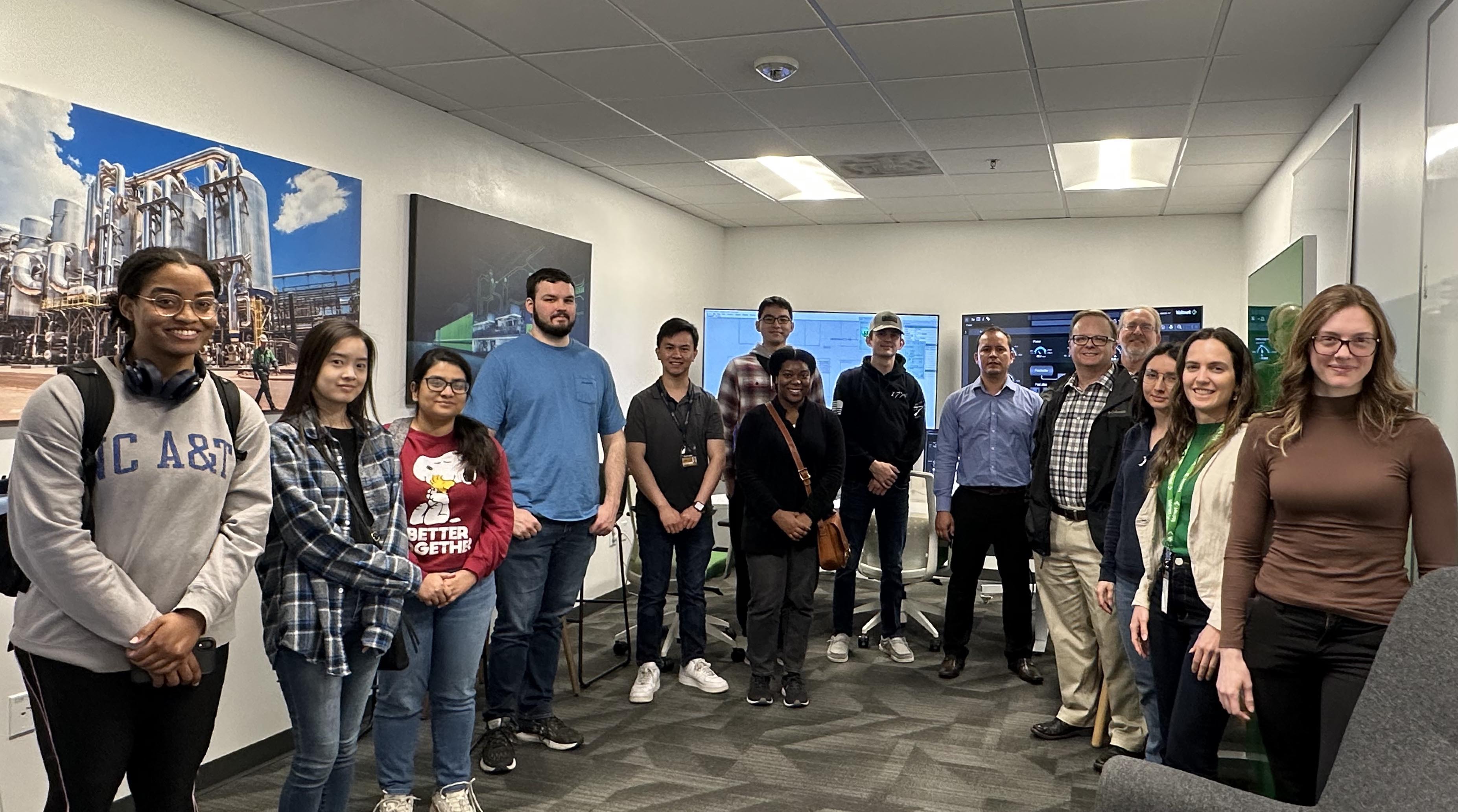
Georgia Tech Students and Faculty and Valmet personnel at Valmet Automation’s Norcross Location
Priya Devarajan | RBI Communications Manager
2023 RBI Spring Workshop Experience from a Student's Perspective - Part 1
Aug 01, 2023 —

Elyssa Ferguson, RBI Fellow during the Student Poster Session at the 2023 RBI Spring Workshop on Packaging Innovation and the Circular Economy
A highlight of the Renewable Bioproducts Institute (RBI) workshops is the student poster session that provides industry interaction for Paper Science and Engineering (PSE) Fellows and an opportunity to communicate the breadth of research supported by RBI to the workshop participants. The session also provides a chance for new students to share their project scope, goals and receive useful feedback. This is the first of a series of Q&As from PSE students who share their experience at the 2023 RBI Spring Workshop on Packaging Innovation and the Circular Economy Elyssa Ferguson, a Mechanical Engineering graduate student shares her experience below.
Tell us about yourself
My name is Elyssa Ferguson. I earned my B.S. in mechanical engineering at the University of Maryland, Baltimore County (UMBC). I am pursuing my M.S. in mechanical engineering at Georgia Tech. I am an RBI Fellow, GEM Fellow, and Women of Woodruff (WoW) Fellow, and I work in the Water-Energy Research (WERL) Lab, under the direction of Akanksha K. Menon, assistant professor in the School of Mechanical Engineering. My research focuses on developing sustainably sourced natural fibers for thermal insulation in buildings. My project is a part of the Carbon-Negative Building Materials based on Engineered Wood for Structural and Thermal Insulation Applications project. Menon and I collaborate with Kyriaki Kalaitzidou, Rae S. and Frank H. Neely Professor in the School of Mechanical Engineering and Joe F. Bozeman III, assistant professor in the School of Civil and Environmental Engineering and Public Policy. I also work with graduate students, Elnaz Jamshidi from the School of Materials Science and Engineering and Arjun Thangaraj Ramshankar from the School of Civil and Environmental Engineering on this project.
How was your experience at the RBI workshop?
Attending the RBI workshop was a valuable learning experience. I learned about the variety of exciting work in the renewable packaging realm that is going on at Georgia Tech and other organizations. This work is driving sustainable innovation, yet there are challenges. The discussions regarding the barriers to innovation and areas for growth were very thought-provoking and motivating.
What was your main takeaway from the poster session?
During the poster session, I shared information about my research and had the privilege to talk to many people in the industry. There is much interest in thermally insulating natural fibers for building applications and for other applications like cold-chain packaging and textiles. Speaking with the workshop participants during the poster session broadened my mind to the potential myriad of applications for natural-fiber-based thermal insulation on a global scale. I also learned more about the existing challenges researchers and industrial peers are facing – one being the lack of standardization of nomenclature and methodology. Receiving positive feedback on the design of my poster was also helpful. I deliberately designed a poster that incorporated aesthetics to convey my ongoing research. I plan to apply the helpful information and feedback that I received during the RBI workshop to my future work.
What more would you like to see in future events at the Renewable Bioproducts Institute?
I am very interested in seeing more seminars related to sustainable building materials, especially insulating materials, and textiles, as these topics are closely related to my research project. Fascinating work is happening at other universities and at companies in Georgia and around the world. It would be great if there is a seminar series including these organizations.
Priya Devarajan || RBI Communications Program Manager
